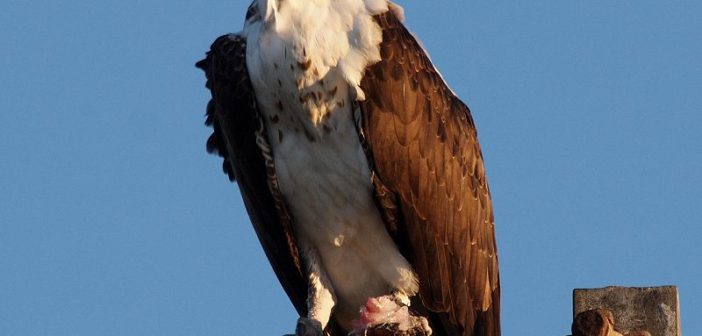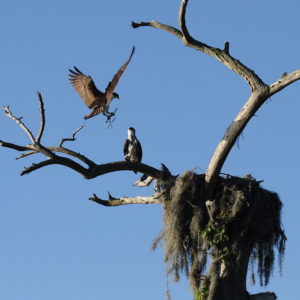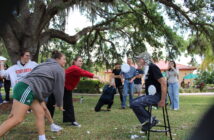By Stetson Snead
As Valentine’s Day draws near, one Saint Leo couple is looking to the future as they set about building a home. A pair of ospreys has been seen constructing a nest on top of one of Thomas B. Southard Stadium’s light poles.
For several days now, the ospreys, which Buddhist culture calls the “Kings of the Birds,” have been hard at work, bringing branches large and small as they work to build one of the largest nests of all birds. When finished, the nest may be more than six feet in diameter and weigh nearly 300 pounds. Unfortunately for Saint Leo’s pair of resident osprey, the recent rains appear to have damaged the nest, causing it to droop down into the lights. The sea eagles, as osprey are also known, have been working double time to repair the nest and get it finished by the spring when eggs will arrive.
Despite the setback caused by Florida’s weather, the couple must feel that they have scored a prime piece of real estate. Ospreys normally build their nests very high off the ground, typically in tall trees or on cliffs. In flat, palm tree covered Florida, it does not get much higher up than atop a set of stadium lights. The distance between light sets means that the birds will not have to worry about any annoying neighbors, and they have quick and easy access to Lake Jovita, where they will be able to dine on their favorite food of fish.
Although in other regions osprey are known to migrate vast distances, Floridian osprey tend to stay in the same area year-round, no doubt to enjoy the mild winters and abundant food supply. Ospreys are a global species, found on every continent except Antarctica. They may weigh nearly five pounds, have a wingspan of 70 inches, and live more than 25 years. The species is recognizable by their white heads, with black “masks” surrounding their golden eyes. These masks extend as stripes all the way down the bird’s necks.
In the United States, osprey’s only natural predators are larger birds of prey, including great horned owls and bald eagles. Because they compete for the same food supply, bald eagles are more likely to bully ospreys and prevent them from getting food than they are to eat the smaller bird. Despite being picked on by America’s national bird, ospreys thrive worldwide and the International Union for Conservation of Nature, the organization which maintains the Endangered Species list, lists them as being least concern for conservation.
Ospreys raise two to four chicks a year, spending five months caring for their young. Both the parents are equally involved in care for the offspring and work around the clock to keep the hungry hatchlings fed. Like most eagles, including the bald eagle, ospreys mate for life, so the couple on campus may be above the baseball field on Valentine’s Day and for many years to come.







